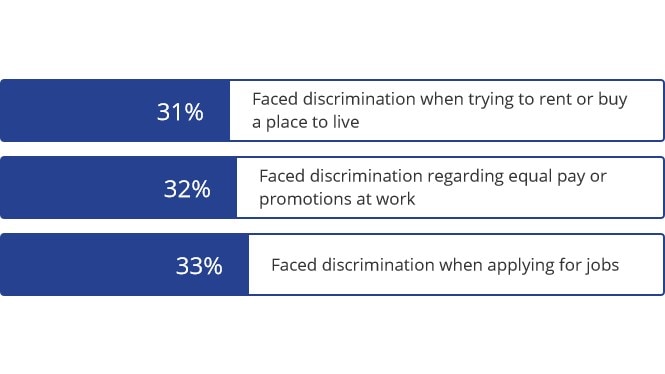At a glance
- The tobacco industry targets Hispanic/Latino communities with marketing and advertising.
- Stress can increase commercial tobacco use and can make health problems worse.

Overview
Some U.S. historical policies and practices have led to mental and physical health risks and challenges, and related long-term health outcomes, for Hispanic/Latino people. For example:
Historically, Hispanic/Latino people in the U.S. have faced racial, ethnic, and anti-immigrant prejudice, including discrimination in employment, housing, and education.1 Acts of violence and hate crimes have also caused injuries and deaths among Hispanic/Latino people in the United States. 23
Hispanic/Latino people have also experienced discrimination and harm from systems meant to protect and improve health and well-being. Some examples of historical policies and practices that have important implications for the mental and physical health of Hispanic population groups include:
- State and federal programs in the 1920s sought to change diets of Mexican American families in the U.S. based on the mistaken belief that traditional Mexican foods were less nutritious than standard American diets.4 This resulted in negative effects on Mexican American health. Today, children of Mexican origin in the U.S. are more likely to experience obesity than other children in the U.S. and children who live in Mexico.5
- Harm and uneven treatment from health care systems, such as the sterilization of Hispanic/Latino women without their permission, led to a mistrust of health care systems and medical providers by some Hispanic/Latino people.67
- Discrimination and distress related to immigration policies, such as the Illegal Immigration Reform and Immigrant Responsibility Act of 1996, have led many people who live in immigrant communities to avoid interacting with public officials.89 As a result, many Hispanic/Latino people who are legally eligible for public health insurance coverage or health services do not enroll.8 Additionally, anti-immigrant public discourse, as well as decreased access to employment, has caused distress.10
There are also current reasons—like the ones explored below—that help explain why commercial tobacco affects the health of Hispanic/Latino people.A
The tobacco industry targets Hispanic/Latino communities with marketing and advertising
Marketing plays a big role in whether people try or use commercial tobacco products. Commercial tobacco ads make smoking seem more appealing and increase the chance that someone will try smoking for the first time or start using commercial tobacco products regularly.11121314

- Tobacco companies heavily advertise Spanish-language cigarette brand names such as "Rio" and "Dorado" to the Hispanic/Latino community, including ads in many Spanish-language publications.15
- Tobacco companies have donated to influential community groups, universities and colleges, and scholarship programs supporting Hispanic/Latino people. 15The tobacco industry has also provided significant support to Hispanic/Latino political organizations, cultural events, and the Hispanic/Latino art community.15
- Tobacco companies use price promotions such as discounts of products like cigarillos and little cigars in neighborhoods with a higher concentration of Hispanic/Latino people. In one study, little cigars and cigarillos were more likely to be sold by stores in communities with a majority of Hispanic/Latino residents (vs majority non-Hispanic White residents). In the same study, most stores surveyed in communities with a majority of Hispanic/Latino residents sold such products for less than $1.16
- A 2009 federal law prohibited cigarette and smokeless tobacco brand sponsorship of cultural events, but other product types, like e-cigarettes and little cigars, are not covered by these restrictions. Tobacco companies are still promoting cultural events designed to bring in youth of color—like a campaign for little cigars that held pop-up concerts featuring hip-hop stars in convenience stores.17
To help protect Hispanic/Latino people from tobacco marketing and discourage tobacco product use, states and communities could consider increasing prices and prohibiting price discounts, prohibiting the sale of flavored tobacco products, and either allowing fewer stores in a neighborhood to sell commercial tobacco products or prohibiting tobacco product sales altogether.18
Stress can increase commercial tobacco use, and can make health problems worse
When people face many forms of stress—such as that caused by financial problems, discrimination, or unsafe neighborhoods—they can be more likely to smoke.192021 Hispanic/Latino people have been overrepresented among Americans in poverty and, overall, are more likely have lower socioeconomic status than white people.22 One in six Hispanic households have at least one person going hungry at some point during the year.23
Racism and discrimination are constant sources of stress for many Hispanic/Latino people.24 Nearly one third of Hispanic/Latino people in the U.S. say they have personally been discriminated against because of their ethnicity:25

When people have severe or long-lasting stress, their bodies respond by raising stress hormones and keeping them raised. When this goes on for a long time, they may develop health problems like high blood pressure and type 2 diabetes.2728 Smoking cigarettes also leads to disease and disability and harms nearly every organ in the body.11
- "Commercial tobacco" means harmful products that are made and sold by tobacco companies. It does not include "traditional tobacco" used by Indigenous groups for religious or ceremonial purposes.
- Feagin JR, Cobas JA. Latinos Facing Racism: Discrimination, Resistance, and Endurance. 1st ed. Routledge; 2014. Accessed March 1, 2022. https://doi.org/10.4324/9781315633749
- Carrigan WD, Clive W. The lynching of persons of Mexican origin or descent in the United States, 1848 to 1928. J Soc Hist. 2003;37(2):411–438. Accessed March 1, 2022. https://www.jstor.org/stable/3790404
- Masucci M, Langton L. Hate Crime Victimization, 2004–2015. Bureau of Justice Statistics, U.S Department of Justice; 2017. Accessed March 1, 2022. https://bjs.ojp.gov/content/pub/pdf/hcv0415.pdf
- Ochoa EC. From Tortillas to Low-carb Wraps: Capitalism and Mexican Food in Los Angeles since the 1920s. Diálogo. 2015;18(1):33–46. Accessed March 1, 2022. https://via.library.depaul.edu/cgi/viewcontent.cgi?article=1399&context=dialogo
- Hernández-Valero MA, Bustamante-Montes LP, Hernández M, et al. Higher risk for obesity among Mexican-American and Mexican immigrant children and adolescents than among peers in Mexico. J Immigr Minor Health. 2012;14(4):517–522. doi:10.1007/s10903-011-9535-9
- Armstrong K, Ravenell KL, McMurphy S, Putt M. Racial/ethnic differences in physician distrust in the United States. Am J Public Health. 2007;97(7):1283–1289. doi:10.2105/AJPH.2005.080762
- Novak NL, Lira N, O'Connor KE, Harlow SD, Kardia SL, Stern AM. Disproportionate sterilization of Latinos Under California's Eugenic Sterilization Program, 1920–1945. Am J Public Health. 2018;108(5):611–613. doi:10.2105/AJPH.2018.304369
- Perreira KM, Pedroza JM. Policies of exclusion: implications for the health of immigrants and their children. Annu Rev Public Health. 2019;40:147–166. doi:10.1146/annurev-publhealth-040218-044115
- Pedraza FI, Nichols VC, LeBrón AMW. Cautious citizenship: the deterring effect of immigration issue salience on health care use and bureaucratic interactions among Latino US citizens. J Health Polit Policy Law. 2017;42(5):925–60. doi:10.1215/03616878-3940486
- Philbin MM, Flake M, Hatzenbuehler ML, Hirsch JS. State-level immigration and immigrant-focused policies as drivers of Latino health disparities in the United States. Soc Sci Med. 2018;1982(199):29–38. doi:10.1016/j.socscimed.2017.04.007
- U.S. Department of Health and Human Services. The Health Consequences of Smoking: 50 Years of Progress. A Report of the Surgeon General. Centers for Disease Control and Prevention, U.S. Department of Health and Human Services; 2014. Accessed March 1, 2022. https://www.ncbi.nlm.nih.gov/books/NBK179276/
- Carson NJ, Rodriguez D, Audrain-McGovern J. Investigation of mechanisms linking media exposure to smoking in high school students. Prev Med. 2005;41(2):511–20. doi:10.1016/j.ypmed.2005.01.002
- Charlesworth A, Glantz SA. Smoking in the movies increases adolescent smoking: a review. Pediatrics. 2005;116(6):1516–28. doi:10.1542/peds.2005-0141
- National Cancer Institute. Tobacco Control Monograph 19: The Role of the Media in Promoting and Reducing Tobacco Use. NIH Pub. No. 07-6242, 2008. Accessed March 1, 2022. https://cancercontrol.cancer.gov/brp/tcrb/monographs/monograph-19
- Robinson RG, Barry M, Bloch M, et al. Report of the Tobacco Policy Research Group on marketing and promotions targeted at African Americans, Latinos, and women. Tob Control. 1992;1:S24–S30. doi:10.1136/tc.1.suppl1.S24
- Smiley SL, Kintz N, Rodriguez YL, et al. Disparities in retail marketing for little cigars and cigarillos in Los Angeles, California. Addict Behav Rep. 2019;9:100149. doi:10.1016/j.abrep.2018.100149
- Ganz O, Rose SW, Cantrell J. Swisher Sweets 'Artist Project': using musical events to promote cigars. Tob Control. 2018;27:e93–e95. doi:10.1136/tobaccocontrol-2017-054047
- Robertson L, McGee R, Marsh L, Hoek J. A Systematic Review on the Impact of Point-of-Sale Tobacco Promotion on Smoking. Nicotine Tob Res. 2015;17(1):2–17. doi:10.1093/ntr/ntu168
- Slopen N, Kontos EZ, Ryff CD, Ayanian JZ, Albert MA, Williams DR. Psychosocial stress and cigarette smoking persistence, cessation, and relapse over 9-10 years: a prospective study of middle-aged adults in the United States. Cancer Causes Control. 2013;24(10):1849–1863. doi:10.1007/s10552-013-0262-5
- Slopen N, Dutra LM, Williams DR, et al. Psychosocial stressors and cigarette smoking among African American adults in midlife. Nicotine Tob Res. 2012;14(10):1161–1169. doi:10.1093/ntr/nts011
- Purnell JQ, Peppone LJ, Alcaraz K, et al. Perceived discrimination, psychological distress, and current smoking status: results from the Behavioral Risk Factor Surveillance System Reactions to Race module, 2004-2008. Am J Public Health. 2012;102(5):844–851. doi:10.2105/AJPH.2012.300694
- U.S. Census Bureau. Poverty rates for Blacks and Hispanics reached historic lows in 2019. America Counts: Stories. September 15, 2020. Updated December 9, 2021. Accessed March 1, 2022. https://www.census.gov/library/stories/2020/09/poverty-rates-for-blacks-and-hispanics-reached-historic-lows-in-2019.html
- Coleman-Jensen A, Rabbitt MP, Gregory CA, Singh A. Household Food Security in the United States in 2019. Economic Research Service, U.S. Department of Agriculture; 2020. Economic Research Report 275. Accessed March 1, 2022. https://www.ers.usda.gov/publications/pub-details/?pubid=99281
- Slavich GM. Life stress and health: a review of conceptual issues and recent findings. Teach Psychol. 2016;43(4):346–355. doi:10.1177/0098628316662768
- Discrimination in America: Experiences and Views. Harvard T.H. Chan School of Public Health, Robert Wood Johnson Foundation, and National Public Radio. October 24, 2017. Accessed March 1, 2022. https://www.rwjf.org/en/insights/our-research/2017/10/discrimination-in-america--experiences-and-views.html
- Discrimination in America: Experiences and Views of Latinos. Harvard T.H. Chan School of Public Health, Robert Wood Johnson Foundation, and National Public Radio. October 2017 Accessed March 1, 2022. https://legacy.npr.org/documents/2017/oct/discrimination-latinos-final.pdf
- Juster RP, McEwen BS, Lupien SJ. Allostatic load biomarkers of chronic stress and impact on health and cognition. Neurosci Biobehav Rev. 2010;35(1):2–16. doi:10.1016/j.neubiorev.2009.10.002
- Guyll M, Matthews KA, Bromberger JT. Discrimination and unfair treatment: relationship to cardiovascular reactivity among African American and European American women. Health Psychol. 2001;20(5):315. doi:10.1037//0278-6133.20.5.315
